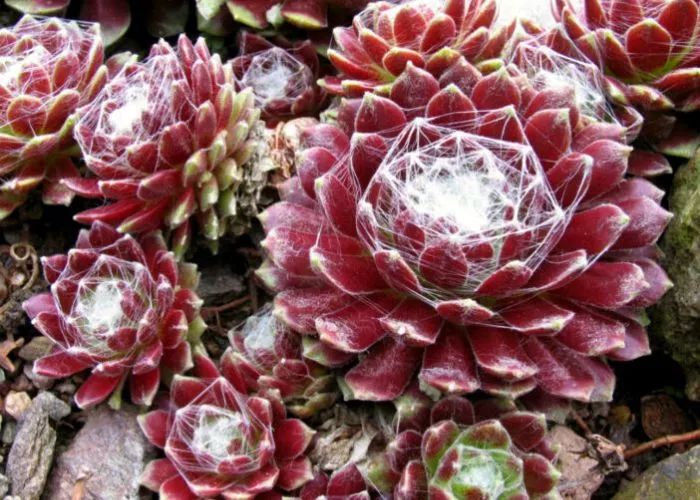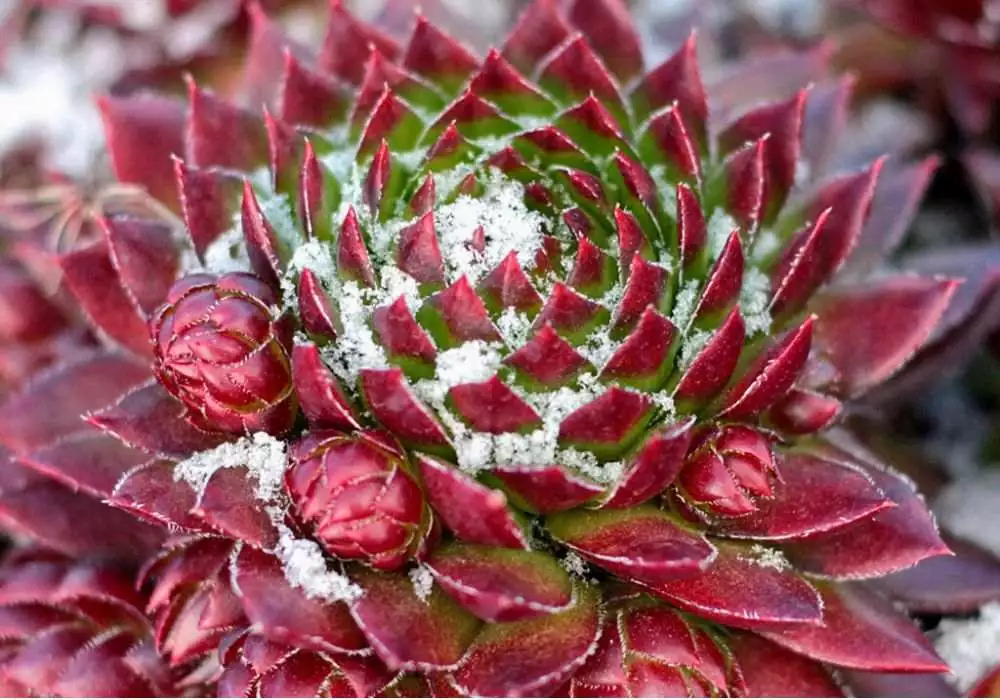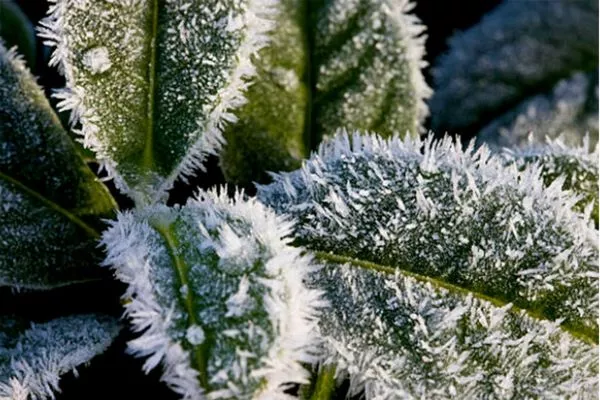The most common species of succulent originate in warmer climates. But, there are some lesser-known variants (known as ‘hard’ succulents) which can tolerate the cold more than others.
So, when a plant of this ‘soft’ succulent nature (common ones) is left in temperatures below 40°F (4-5°C), its plump, moisture-filled leaves and stems will freeze. Ice crystals form within the leaves and damage the cells.
But, can you revive a frozen succulent? That’s our primary concern here, and I will try to decode it for all of you.
Yes, you can revive a frozen succulent. In fact, there are some mitigation measures that you can take, including keeping your plant sheltered undercover, having some kind of windbreak or even ‘overwintering’ them by moving them indoors during the colder periods.
A frozen succulent shows signs of wilt, then turn brown, then black and ultimately die if left unattended.
Knowing what signs to look for in a frozen succulent is important. It could be the difference between survival and your plant’s rubbish heap.

Table of Contents
At what temperature do succulents freeze?
Succulents are a smart type of plant. They store water within their leaves for dormant periods such as winter. During these times, they use very small amounts of their water supply to keep them alive whilst in this state.
Any temperature below 40°F (4-5°C) can be dangerous for a succulent.

When the mercury reaches 32° F (0°C), it’s a panic station for these plants and a good reason. Like any moisture source that extremely cold temperatures are applied to, the leaves of a succulent can also suffer from becoming frozen.
The water inside crystallizes as it turns to ice. The first thing you should do if this occurs is to try to place your plants in an area away from the cold. E.g., Inside, undercover, etc.
This will allow the plant to at least gain some kind of energy to attempt a recovery.
Can You Revive a Frozen Succulent? (The Answer)
A frozen succulent can be revived if the frostbite has not managed to make its way to the root system. Once the frostbite has travelled down there, the roots lose their ability to search for food or water to gain the strength and energy to recover.
If the temperature stays below freezing point 32°F (0°C) for an extended period, the amount of damage caused can be significantly amplified. E.g., As the water inside the succulents suffers from extreme temperatures, the cell walls burst and turn the leaves into what can be recognized as a gooey mush.
However, if the succulent is subject to a lighter frost for shorter periods, the leaves may just become frostbitten. This is a much better result for the plant and can be treated with positive effects.
Succulents can survive being frozen for shorter periods, but it also depends on the damage caused by the colder temperatures.
Signs That Indicate Frozen Succulents is Revivable?
If you notice your succulent suffering from the cold, the best thing is to place it somewhere out of the cold to help it regroup and recover.
Leave it there for 4-7 days and check its condition periodically to see if any of its characteristics change.
One of the biggest indicators of knowing if your succulent can be revived is the condition of the stem. If the stem is rock-hard frozen, it will be extremely difficult to save. The plant’s nutrients travel up through that stem to supply nourishment.

If its food supply is cut off, it simply cannot live. Another key indicator is if you notice any new growth from the base of the plant. If so, this means that nutrients can still move around freely.
As a result, you will be able to breathe some life into it before it’s too late.
What does cold damage look like on succulents?
There are varying degrees of visual damage signs that you can look out for with a succulent subject to extreme colds.
Firstly, look for wilting leaves. This is an early sign of frostbite. If left unattended, the leaves will start to turn brown and darken towards more of black color.
Once it turns black and crispy, it will begin to rot. You may also notice that the once plump leaves become rock hard. This happens when the water inside freezes and crystalizes. The cell walls swell up and burst and often deform the shape of the leaves.
How do you revive frostbitten succulents?
Depending on how much frostbite your succulent has been subject to, there may still be hope. If the leaves of your plant are only slightly faded and are tinged with a brownish/yellowish color, they should be savable.
If this is the case, then it’s time to find a warm, dry area and a round-up of a few tools and get to work.

You should get yourself a pair of clean, decent-quality pruning scissors or shears. Making sure they are sterile and clean is extremely important.
When pruning succulents, you usually open their juicy flesh up, so making sure they aren’t subject to any bugs or disease is imperative.
Prepare and Place Your Succulents Indoor
The first thing that you should do when you notice one of your succulent plants struggling with the cold weather is to move it. Move it somewhere either inside (optimal) or where it can get a little relief away from exposure.
For example, under a porch roof, next to a windbreak or even in a garage.
You can leave it outside all winter if the winters aren’t consistently below that 40°F (4-5°C) for long periods. Otherwise, they risk rotting and dying if they are left too long.
Once you move the plant, observe it for 2-3 days and see if it starts to sprout any new growth. If it does, it’s a sure sign that it is still alive and can be saved.
Remove Damaged parts and Give them time To Heal
Once it is completely dry and thawed out, it’s time to start taking action. Remove any discolored and damaged foliage using your disinfected shears, scissors, or even a knife.
Make your cuts slightly lower than the affected areas to ensure they can’t spread upwards. When satisfied with your prune work, wait a day or so for the plant’s raw limbs to callous before applying any water.
If you notice that a fair bit of the plant is damaged, you may need to remove the whole plant from its pot, clean up the roots and repot it fresh again. If your plant is too far gone, you can always take a cutting that can be used to propagate and start again with that limb.
Cover Succulents with a Cloche
Another option you could consider is using a cloche. They can come in a few different materials, including plastic and glass. The idea behind them is to trap humidity, almost simulating a greenhouse which gives the plant the moisture needed and time to heal.
They are a dome with a handle that is lowered over the plant. Using glass and plastic assists with drawing in the sun, trapping the heat, and giving the user an easy view of their plant.
Change watering Schedule
Observe your plant for the next 6-7 days after the limbs start to callous. Once they begin to heal, apply small amounts of water every 3-4 days. Succulents don’t require much water during winter as they are dormant.

Apply a Frost Cloth
If your succulents are growing outdoors, you can layer the base of the plant with mulch, hay or frost cloth to help insulate the root area. Protecting that section is important to the life of the plant.
Frequently Asked Questions (fAQs)
How do you tell if plants are dead after freezing?
If no new growth appears within 3-4 days of moving it out of the extreme temperatures and treating it accordingly, it is likely lifeless. It’s best to even give it an extra couple of days once it thawed out.
Can Cactus recover from freezing? How to revive a frozen Christmas cactus?
It is not uncommon for a cactus to recover from frostbite and/or to freeze without tending to them. It all depends on how cold it gets and for how long. You can always cover up any plants you may have with burlap, hay or mulch to give the roots a bit of extra insulation.
As far as Christmas cacti are concerned, there are a few ways you can go about it. Either cut a limb and propagate or use an oscillating fan that can emit a warm breeze to try to thaw it out. The latter will work, but it depends on how badly damaged the plant is.
How to Save a Frozen jade plant?
Jade plants are quite sensitive to extreme cold, so it’s not ideal to have them growing outside during these times. Saving a Jade plant from frostbite requires thawing, pruning away affected areas, drying out some more, and slowly watering to bring it back from death’s door.
Conclusion:
So, can you revive a frozen succulent?
Yes, they can recover from frostbite as long as the plant hasn’t been too deeply affected and for too long. The process isn’t too difficult either.
Thaw them out, remove the affected area with care using clean tools and be patient. You should start seeing signs of regrowth within the week. We hope that this article has been helpful. Happy growing!


